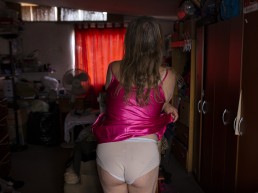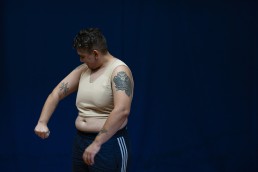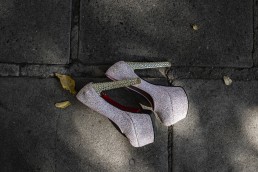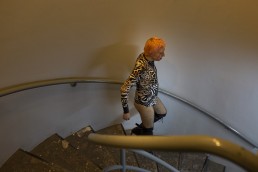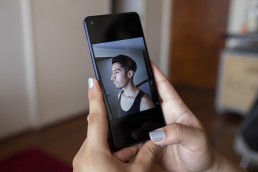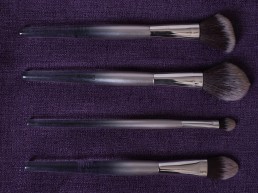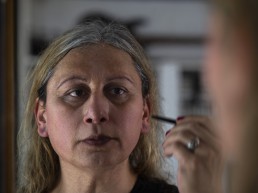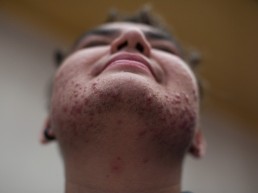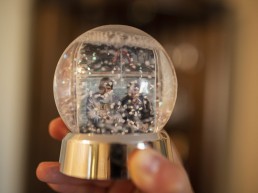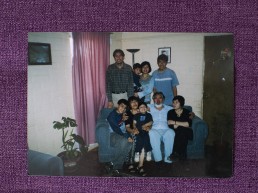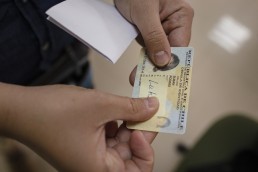Performativity
About
Performativity
Although we tend to think of gender as one more attribute of our bodies, gender theory tells us that gender is more of a performance, the iterative and continuous performance and interpretation of gender in conjunction with the physical body. This performance is what ultimately makes gender a social reality.
The philosopher Michel Foucault argued that since the 18th century, practices of self-expression have shifted from a tactic for denying our true nature to a technology for the continual construction of the self. This is echoed in Judith Butler’s theorization of gender performativity.
Through the lens of the performativity of gender, it becomes clear that gender is a social construction that changes with sociocultural context. However, the effects of this social construction are clearly real, and they create the basis for many of the forms of discrimination faced by the participants in this project.
Gender is not inherent or immutable, but is constructed through the relationship between the gendered expectations of one sociocultural group or another and the expectations of the physical body in this same society: Boys like/do that, and girls like/do that.

Feño:
My fourth year class trip was really my first taste of freedom. I left, I dyed my hair, I had a mohawk! And I went out wearing a tuxedo, and my dad screamed to high heaven because I had gone out in men's clothing.
The line between the purposeful construction of a non-normative self and embodying a novel but increasingly hegemonic gender identity is perilously thin.
Representations of the self must be read as constantly in flux, oscillating between new forms and ideas of gender, and the adoption and eventual normalization of these once dissident forms of gender identity and expression.
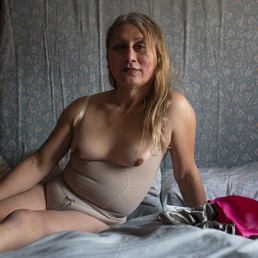
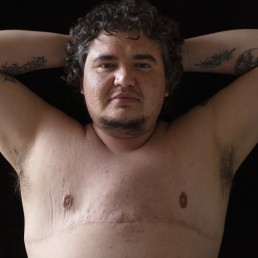
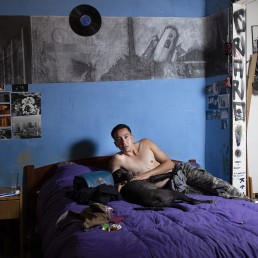
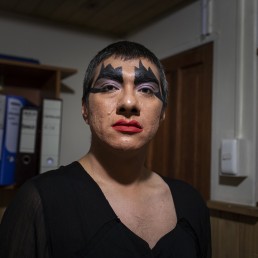
As one definition of selfhood becomes overly rigid, another emerges to destabilize it. That is, there is no inherent, pre-social self, but rather one that is continually and iteratively built over one’s life and in relation to one’s surroundings.
Rayen:
Even though I don't consider myself a drag queen, it still has a lot of influence on what I do (as an artist). And in terms of my somewhat grotesque aesthetic in relation to conventional drag.
Cata:
So if a woman wants to be a man, she is moving up in status. That's good. She is gaining power; she’s gaining privilege. Now, if a man wants to degrade himself into a woman, which is how the patriarchy sees the issue, it’s like “Dude. Why? You’re losing privileges. You’re moving down the scale. We’re trying to get more, not less."
So, although the physical body — materially speaking — does exist, gender is one of many ways to turn that raw material into an intelligible being for society.
Pedagogies
About
Pedagogies
Although gender identity is very personal, we also know that in each sociocultural context, there are gender norms that define acceptable and marginalized forms of masculinity and femininity.
Gender ideals change little by little, as society changes, and often almost imperceptibly. However, these changes always occur within the binary gender matrix, maintaining a continuous difference between men and women that changes in form but not in function.
The invisibility of the binary gender matrix for cisgender people allows many of them to understand their gender as innate. Since their gender expression coincides with the expectations of the gender that was assigned to them at birth, pedagogies of “how to be a lady” or “how to be a gentleman” go unnoticed.
Unlike cis people, people with gender expressions that do not fit normative gender expectations —such as trans and non-binary identities— do not benefit from this passive pedagogy of gender, and so they tend to look for references in their environment and therefore internet to help them define and explore their identity.
Cata:
Well, at first I said no, “I think I'm a travesti.” And then I came across the term gender fluid and I said “no, maybe that's my label,” what I called it back then, because I said “damn, I feel super comfortable when I'm a woman.” But also out of fear, I unconsciously told myself, “No, I don't think I would live my whole life as a woman. There are many ‘man things’ that I like.” And what happened? Trans camp, which was a really beautiful initiative organized by a Facebook group of trans men, who extended the invitation to trans women.
Though representing the body digitally is often fraught, many trans peoples’ use of social media is intimately linked to their physical bodies. Rather than reducing the body to a mere abstraction, many trans people use the audiovisual and textual specificities of social media to express embodied identities, including corporeal changes like cellulite, scars, and surgical drains.
The combination of this content with the immediacy of social media creates a feeling of experiencing each step of the author’s transition alongside them. These transition videos are one of the most popular and archetypal forms of trans social media activity.

Luka:
Thanks to Twitter, I found out that there were other trans men...Suddenly there was a trans boy who appeared there. And I said "oh, this exists." And I started to discover more trans guys and the hashtag #transguytwitter and I got in and started to see photos. I started to see the transitions, and I cried. I cried with happiness. I was crying with hope, and I said, “this is me.”
Marcia:
I've always liked designing clothes, and well, I've been drawing since I was little. So my mom, she saw that all my brothers were playing football with the men outside and I was inside, drawing little girl's dresses and things like that. And she hated that. She wanted me to go play ball. She forced me to be macho.
Trans content online constitutes, both intentionally and often inadvertently, a kind of guide, one that has ramifications for the physical body and its relationship to the self, as they shape viewers’ imaginaries of possibilities for their own embodied trans identities.
Sexuality
About
Sexuality
In recent decades, the idea of a strict separation between sexuality and gender has become increasingly popular. While these two axes of our identities perhaps represent two different social realities, gender and sexuality are more closely related than has been historically theorized.
The close-knit relationship between gender and sexuality is due to so-called “compulsory heterosexuality” —the idea that everyone is heterosexual until they declare themselves otherwise— and the privatization of sexual desire.
With sex among the most taboo subjects in Western society, the only indication we have of someone’s sexuality is their gender expression. In other words, homophobia is rarely based on knowledge of someone’s true sexuality, but on a gender expression that communicates homosexuality due to its excess of masculinity or femininity in an unspecified body — for example, the figures of the loca and the camiona.
Cata:
So for me it was even more confusing because it said, “dammit, if I want to be a woman I would have to like men.” And then, like when I was in third or fourth year, I said “no, in reality women can also be lesbians.” And it kind of hit me, because in fact I also had a couple of classmates who were lesbians, and who were the subject of witch hunts at school until they were both expelled.
Because heterosexuality and binary gender are intimately linked within the “heterosexual matrix,” the lack of a particular romantic orientation often makes it difficult for trans people and their networks to understand trans identity for what it is. That is, due to the absence of an attraction to the “appropriate” gender, heterosexual trans people are often mislabeled as homosexuals.
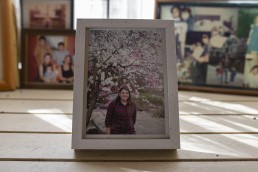
Feño:
I was transphobic with myself. I couldn't accept that I could be trans, because I didn't understand it well. I had only ever seen one documentary with a trans man, and I was still taking it on internally and felt ashamed. So instead I said that I was a lesbian.
The importance of the gender binary was violently enforced by the Pinochet regime, which was particularly invested in a “return” to the “traditional” Chilean family, a heterosexual couple in which the man worked and the woman raised the children.
Despite the Chilean Left’s almost total rejection of non-normative sexuality and gender identities during this period, the Right nonetheless painted the socialists as the party of homosexuals, rendering diverse and dissident people particularly easy and tantalizing targets once the regime gained control. In short, few on either side would have shed tears for a dead loca.
Luka:
Before knowing that I was trans, accepting it, I interpreted it as something else. Like all of this, the clothing that I wore or perhaps the masculine, more rebellious attitude, was like a breastplate or armor, because I was sexually abused and raped when I was 12. So perhaps for some psychologists, all my sexual confusion and identity was because of that.
It is because of this close relationship between gender and sexuality that trans people often first identify as homosexuals, since the conflict between their body (but not their gender identity) and the object of their desire creates the illusion of a homosexual attraction.
Transition
About
Transition
For the general public, trans identities and medical transition —hormones, genital surgery, mastectomies, etc.— are closely linked. It is often thought that when transitioning, a trans person begins as one gender, undergoes medical interventions, and comes out as another gender. However, this emphasis on physical transition overshadows a much more complex and non-linear process of social transition.
Transition is a process that has no end, since gender is made and remade as we perform it. What’s more, it is often a process that does not have a single starting point, but rather many.
By understanding transition outside of a linear framework, it is revealed as a process full of both uncertainty and opportunity. It is a time to rethink everything one has learned about gender throughout their life, investigating not how their gender should be, but rather how it can be, giving trans people the opportunity to build gender identities that oppose patriarchal gender norms.
Luka:
When I told him (my dad) I said, “I'm going to wait. I'm going to wait until I have my psychological certificate, and my psychiatric certificate.” And I know that’s pathologizing, and that I did not need it with the other people I came out to.
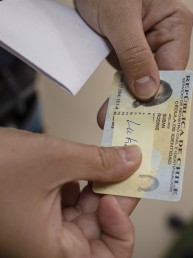
Telling their own transition narratives with the benefit of distance allows many trans people to make sense of an often confusing process. However, as trans theorist Kadji Amin points out, this same insistence on renarrativizing the process of transition as one with a discrete “before” and “after” can also collapse individual trans experiences into transnormative stories that efface the complexity and individuality of navigating gender transition.
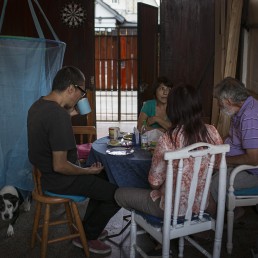
Rayen:
In fact, it was to such a point that I didn’t come out as trans until after I finished university. I've only been in transition for a year. In terms of my childhood? Well, now that I'm older I can realize that I was always trans. Because I liked... feminine things and I was very different from other boys my age.
Theorist Jay Prosser has argued that autobiographical practices “post”-transition allowing trans people to retroactively bring order to what is often experienced as a confusing and chaotic time; in short, the benefit of time allows trans people to retroactively make sense of —and narrativize— their transitions into often neat, linear stories.
The idea that transness is inherent and linear — that all trans people understand themselves as trans from the moment of consciousness — is part of a larger tendency in the global LGBTI movement toward the language of biological determinism.
While on one hand, this “born this way” strategy has proven effective in a variety of sociocultural contexts, it is also imperative that we examine both the logics undergirding this way of thinking.
Despite its political efficacy, a linear understanding of trans temporality obscures and effaces differences in the individual life narratives of trans people, in favor of a narrative of trans gender identity that mimics cisgender identity almost completely.
Marcia:
It’s that thing of wanting to be too visible. But I am realizing that almost all trans girls have this same thing. I mean, when they're just starting out, they hatch out of the egg and come out like they want the whole world to see them, you know? “Please, look at my photo,” or they are sharing it here and there. Like you literally go crazy. And I fell, I realized, “ah, I fell for the same thing.” And the fact that you can just take a picture of yourself and they say that you have a nice body, I don't know… they give you a lot of ‘likes’ and things like that. Of course, at first it’s nice because it inflates your ego… until they start harassing you.
Relationality
About
Relationality
Our genders —and our identities in general— are not born in a vacuum, but are built throughout life through the interactions we have with the people who surround us.
For many, perhaps the most important influence on their development is parents, both for better and for worse. For trans people, the relationship with parents can dictate the future in extreme ways; parental acceptance helps their children feel supported in exploring their identity. On the other hand, rejection — or fear of rejection— causes many trans people to suffer years of anguish over the conflict between who they are and who they “should” be.
Since home and school represent the most important spaces of socialization for children, it is not surprising that they can also be among the most traumatic places for trans children.
Without exception, all the participants in this project have experienced “bullying,” both from their classmates and their family members, in relation to their inability to demonstrate masculinity or femininity in a normative and acceptable way.

Feño:
They made a rule that I couldn't go to the cafeteria… because I had to go through the primary school. And the little girls couldn’t be exposed to me because I was going to put things in their heads. So I had to ask my classmates to buy me a snack every day.
Unfortunately, many trans people suffer from mental illnesses such as depression and anxiety due to the treatment they receive from society beginning at a very young age. It is perhaps not surprising then, that the trans community experiences a much higher suicide rate than their cisgender peers.
The acceptance or rejection of a trans person by their family and friends can dictate the ease with which they will ultimately understand and accept their gender identity.
Many trans people don’t ever “come out,” not because they are unsure about their gender identity, but because they fear threatening or breaking the social ties that sustain them, such as with family, friends, and colleagues.
Interpersonal relationships can also lead to greater self-acceptance for trans people, as long as they are based on acceptance and support.
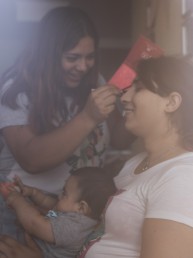
Marcia:
Now, my family never saw me dressed as a woman, or publicly out or anything, you know? I always did what they wanted, and never… I figured out how I could wear women's underwear without anybody asking me any questions. In that sense, even I’m surprised at myself, because I was so intelligent that they never caught me.
Relationships with other trans people also play an important role in the construction of trans identities that are based on self-acceptance and self-love. Being able to witness the experiences of other trans people – both positive and negative – dictates in part what each trans person considers possible.
Luka:
I dated a couple of girls from that group. One of them was named Samantha, and I had her saved in my phone as Sam, so that she was supposedly straight. In case someone checked my cell phone, I had a Sam, a Samuel. Later I was with another girl and her name was Joselyn and I also had her saved as José.






